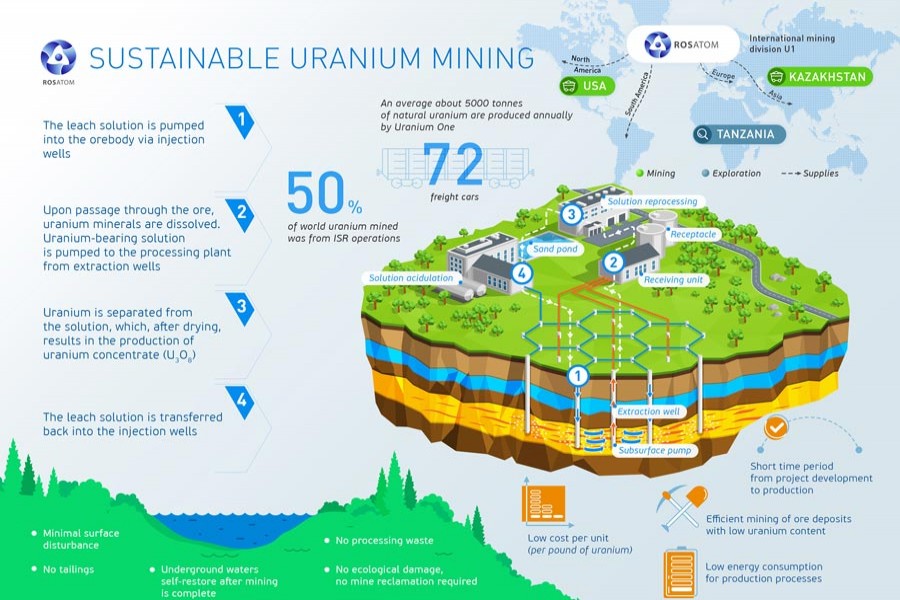According to the International Energy Agency, global energy consumption could see an increase of up to 18 per cent by 2030 and 39 per cent by 2050. This will increase the demand for various sources of energy - including nuclear power, and therefore uranium. "As new power reactors come online and others are retired, proper supply and management of uranium will be a critical factor in energy supply in the coming decades," said Adrienne Hanly, uranium resources specialist at the International Atomic Energy Agency (IAEA). "Uranium-based fuel is expected to remain a basic, reliable source for low-carbon nuclear power. How we utilise this fuel will greatly depend on the development of new technologies and strategies for sustainable resource management."
Even under the IAEA's low case prediction for the future of nuclear power - which would see nuclear energy's share fall from today's 11 per cent of the energy market to just 6.0 per cent by 2050 - nuclear electrical generating capacity would increase by 24 per cent. Under the high case scenario, nuclear power would see a 2.8-fold increase, and nuclear energy's share of the global energy market would increase to 13.7 per cent by 2050.
As new nuclear power technologies mature, in some cases requiring less uranium or using today's nuclear waste as fuel, increase in nuclear power generation does not necessarily mean a proportional increase in the demand for mined uranium. But that demand is expected to rise nonetheless.
How will the industry meet this growth in demand? While there are enough uranium resources accessible with current mining practices for at least 100 years, research is under way to identify different methods for tapping into the world's uranium resources.
One such method consists of extracting uranium from seawater, which contains more than four billion tonnes of dissolved uranium - far outweighing the volume of reasonably assured supply from mining activities on land. Extraction from the sea also promises to be an environment-friendly and sustainable way to supplement the global uranium supply.
Extracting usable quantities of uranium from seawater is theoretically simpler than from ore. The uranium found in seawater is created by steady chemical reactions between the water and rocks that contain uranium. And when uranium is taken from the seawater, the same amount later leaches from the rocks to replace it. Success in this research would mean a virtually unlimited supply.
Methods under development for extracting uranium from seawater involve infusing fibres made of polyethylene, a common plastic, with amidoxime, a substance that attracts uranium dioxide and binds it to the fibre. There are approximately three milligrams of uranium per cubic metre of water, or about the equivalent of a grain of salt per litre. After about a month of soaking them, scientists can remove the fibres and treat them with an acid that collects the uranium and makes the fibres suitable for reuse.
Although this method has been researched for decades, its commercialisation has not yet proven to be economical, given the low price of uranium and the abundance of supply from conventional mines. Over the past five years, the cost of uranium extraction from the sea dropped by a factor of four to US$440 per kilogramme. But the price needs to fall significantly further for this method to be usable on a commercial scale.
Equally important as sustainable uranium acquisition is the efficient use and management of the uranium. Interest worldwide has increased in the use of small modular reactors (SMRs), thanks to their ability to generate flexible power for a wider range of uses and applications. One advantage of SMRs could be that, depending on the technology used, there will be less requirement of uranium for the same output.
Large scale SMR deployment could significantly alter demand and the predictability of the market. Today, the industry caters to a constant demand from large reactors, whose supply needs are different from those of small reactors.
In addition to exploring new technologies for obtaining more uranium, the nuclear energy industry will have to examine practices in resource management to ensure sustainability, Hanly said. The IAEA has been working with the United Nations Economic Commission for Europe (UNECE) in recent years to address issues in resource management, including socio-economic viability, technological feasibility and confidence in estimates.
"Uranium has to be seen as a low-carbon fuel that can help realise many of the United Nations Sustainable Development Goals and climate commitments," said Harikrishnan Tulsidas, Economic Affairs Officer at UNECE. "New technologies will have a critical role to play in making uranium production sustainable."
Noah Mayhew, Correspondent, International Atomic Energy Agency (IAEA) Bulletin. E-mail: [email protected]


